
Paul presented to the club on this topic in May 2023. His presentation is available here.


Paul presented to the club on this topic in May 2023. His presentation is available here.
After I posted on this topic earlier, one of our members initiated a dialog with me via email. I received Ken’s permission to put the discussion here since it helps to clarify the matter.
Ken’s email read:
This is entirely consistent with my recent conversation with DPI. Earlier this year, a number of farmers were chasing non-fishers and fishers off the Goodradigbee, citing a change to the Biosecurity Act as just one of the reasons. This is complete fiction. DPI have confirmed to me that whilst there are newish rules to the Biosecurity Act, these mostly relate to illegal trespass and not legal use of a road reserve or river where fishing is permitted.
You and many people in the club may already know this but it bears repeating. Section 38 of the FMA declares that a river is Crown Land. Irrespective of ownership, s38 declares that the public still has a right to fish despite the private ownership of the bed of a river or creek. Therefore, regardless of whether a farmer does or does not own a river, the public can access it to fish (provided you remain within the river bed). Furthermore, even if a farmer claims to have leased or licensed a TSR, they generally still do not limit use for fishing unless there is an exception – DPI are specifically checking this for the TSRs around and upstream of the Brindabella Bridge. I would also put forward that if there is a dispute about the high water mark and what the river bed is with a landholder, that their opinion of where this mark is has no greater authority or expertise than yours.
I see this with the public’s interface with Governments all the time. The risk with reading any legislation if you are not sufficiently skilled is that people cherry pick bits and pieces to fit their narrative with an inadequate understanding of the framework or the guiding principles of a certain piece of legislation. You can’t just make stuff up.
DPI are working on a whole of state approach to run more effective communications on angler rights and how to liaise with landholders on anglers’ behalf. I have been advised that they are also doing a site inspection of Brindabella Valley Road and meeting with adjoining landholders.
I responded to hopefully clarify a few minor points:
Re ” even if a farmer claims to have leased or licensed a TSR, they generally still do not limit use for fishing unless there is an exception ” … not quite complete. Private or public management might entail a biosecurity plan which might bar access normally provided for via TSR rules. Access can also be barred for ‘operational reasons’ eg spraying. NSWCFA through DPI are pursuing unjustified constraints on access.
A key point that anglers must understand is the definition of the bed … but definitions aside, applying it to particular waterways can be problematic.
Thanks for the advice re DPI getting on the ground. Will assist a lot. Alistair McBurnie has been doing some great work here.
Regardless, approaching landowners in advance will generally be a recommended approach…. that said it can be difficult to identify and locate owners/managers of freehold properties.
Ken responded “You can approach landowners where possible but when you do it’s important to know what the law is and have a clear understanding of your position and rights. What landowners have been relying on is bullying people in the hope that you don’t know what the law is and they can impose their version of the law, which can be adrift from the truth.”
Interestingly, while this discussion was progressing, Jim Harnwell, our key contact in DPI Fisheries, contacted me on another matter. I asked him to examine my blog post re access and Biosecurity. His response was:
Re your blog on S38 and biosecurity: the information you’ve prepared appears to be consistent with the advice provided so no issues my end.
Here’s some other info re biosecurity issues specifically relating to foot and mouth disease concerns.
While in the bed of the creek, access under section 38 of the Fisheries Management Act;
However, if accessing a waterway through a Travelling Stock Reserve or private property (with land holder permission), and there is a Biosecurity Management Plan for that TSR or private property, then anglers must comply to this.
Ken also raised the concept of “permitted purpose” in relation to recreational access to TSRs. Fishing is a ‘permitted purpose’ in certain categories of TSRs but banned in the Western Division of NSW. Other activities may not be permitted, eg camping is banned on TSRs, indeed access is only during daylight hours.
DPI have assembled onto their Angler Access webpage information from a diversity of sources in relation to angler access rights.
There is more on Angler Access in a subsequent post.
In 2022 NSWCFA sought formal advice regarding a possible contradiction between the Fisheries Management Act which allows anglers specific/defined access to streams, and the Biosecurity Act, which allows landowners to have management plans which affect how people access and behave on their properties. I wrote about it in Burley Line but after discussions were raised in a recent CAA meeting, I thought useful to put into ‘Tips’ blog.
Mr Jim Harnwell, DPI Program Leader Stocking & Fisheries Enhancement Operation, sought advice from DPI’s legal team, .
The advice is:
The Biosecurity Regulation states that Division 12, which applies to biosecurity management plans, “does not apply to a person who enters or is in a management area under the authority of an Act or another law.”
Section 38 of the FMA provides authority for fishers to enter land to take fish, in certain circumstances. This means biosecurity management plans do not apply to fishers if they are on land, taking fish, in accordance with section 38.
The authority to be on land under section 38 of the FMA is limited by section 38. For a fisher to rely on section 38 they must be in a boat on the river or creek or on the bed of the river or creek. Bed is defined as “bed of a river or creek includes any part of the bed of the river or creek which is alternatively covered and left bare with an increase or decrease in the supply of water (other than during floods).”
If fishers are not taking fish and in a boat on the waters of a river or creek, or on the bed of the river or creek, any biosecurity management plan on the relevant land will apply to fishers. To be clear, they cannot access land where there is a biosecurity management plan in place beyond the bed of the river or creek, except in accordance with that biosecurity management plan.
The crux then becomes the definition of ‘bed of the river or creek’. This was the subject of another post on the website. Here. Suffice to say if you are standing in the water you are within the law. Standing on dry land of the bank becomes problematic.
Regardless, even if the angler had been accessing the water in accordance with the laws, seeking to argue relevant rights with an aggrieved property owner will generally not go well. Sticking to public access points, or knocking on doors to ask permission removes uncertainty.
The NSW DPI Angler Access website, has the ability to provide you with a georeferenced map of a selected area showing access points. This is in the form of a special pdf. Internet access is required to connect to the access website, but the map created can be downloaded onto your phone for viewing offline.
The pdf map is used by an app called Avenza Maps to display your current location on the map without the need for mobile data connection.
Production of the map is a little complicated. The screenshots here display the process using a phone, but should be easier on desktop computer.
Go to the access website and zoom to the area of interest.
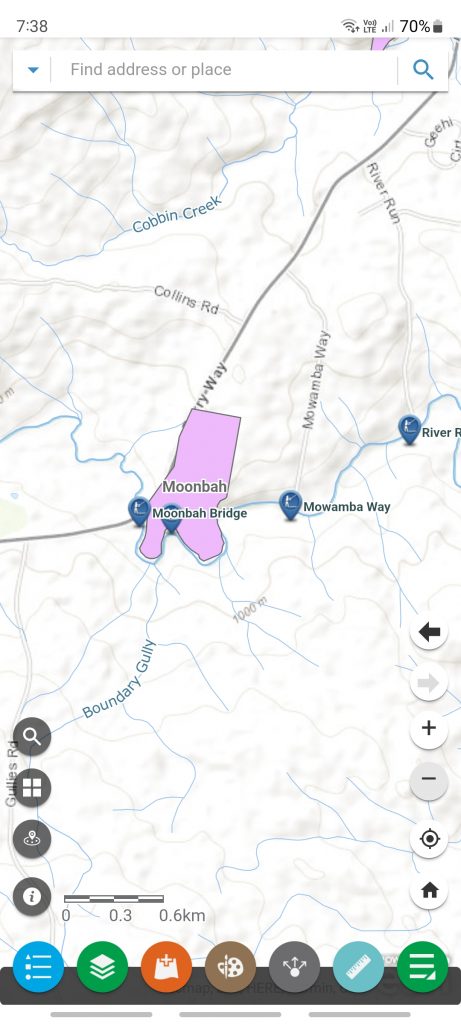
On my phone I couldn’t see the print button but is available via the green button at the bottom right of screen.
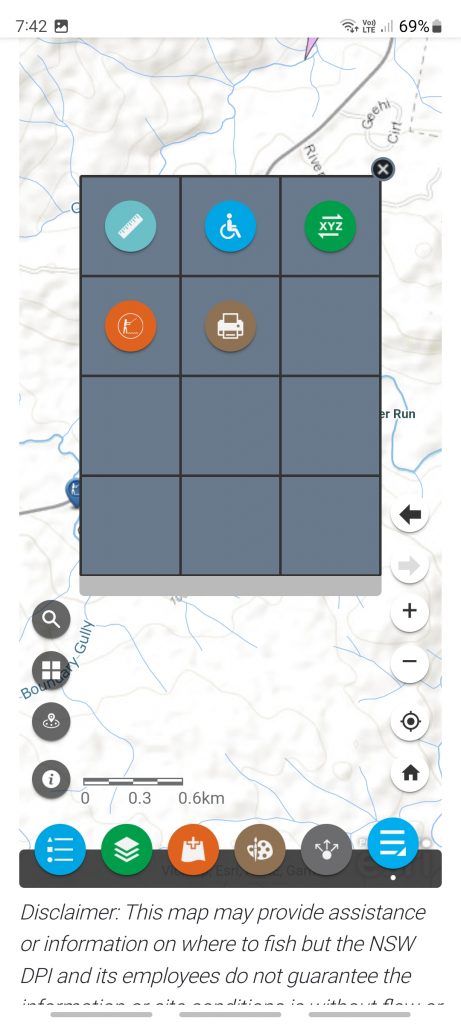
Press the brown print button.
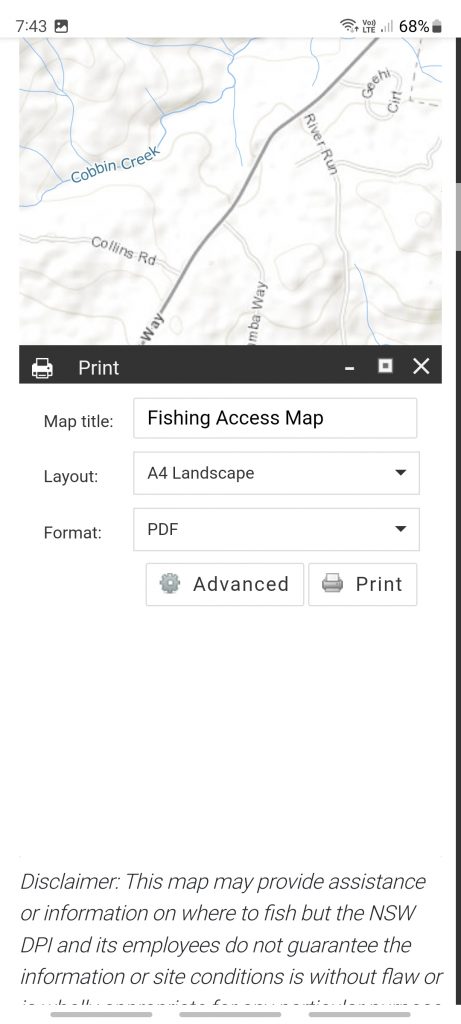
I tinkered with some of the advanced settings – not sure if it had any real effect, but I thought the map should be larger. I also opted for km scale.
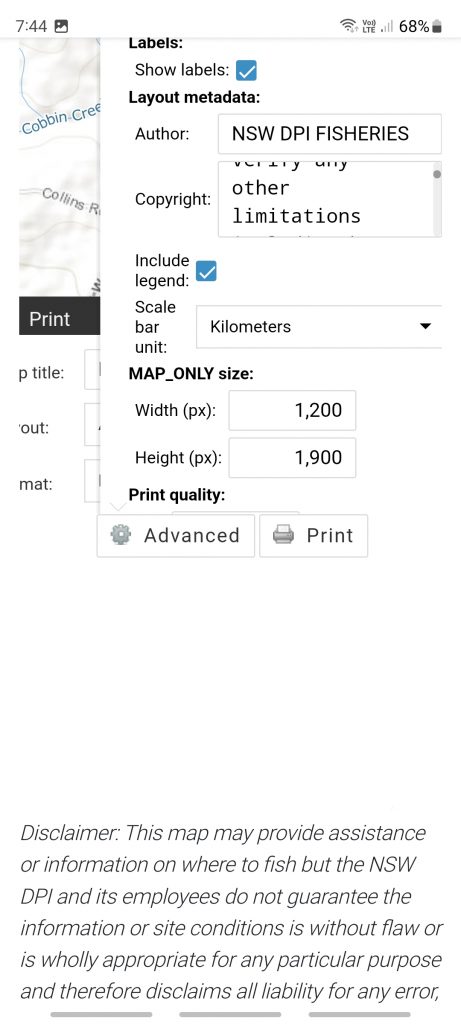
Then hit print button.

Then tap “1. Fishing Access Map”

Tap ‘Save to Downloads’. Unfortunately it will be saved with the horrible name. I take steps via the app MyFiles to rename it.
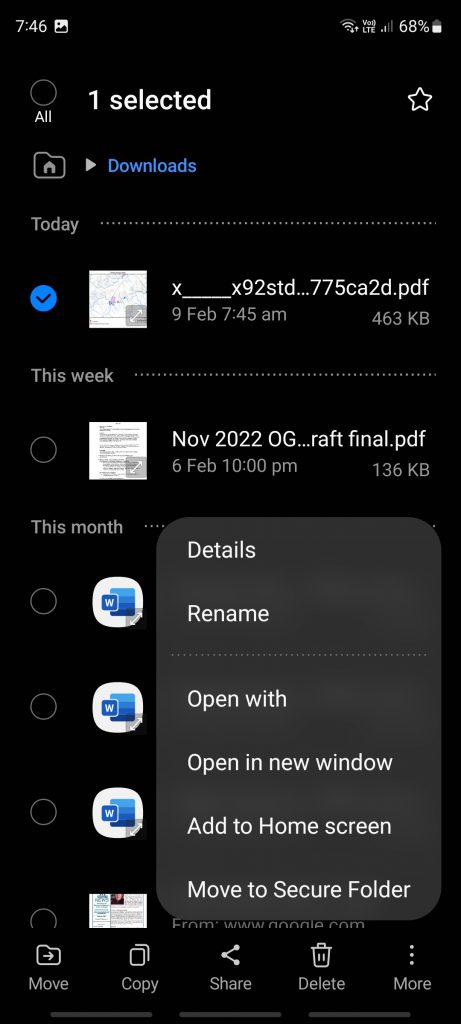
When you open Avenza Maps, go to My Maps which shows maps you have already loaded. Here you can see I’ve got a number already. Unfortunately the free version of Avenza limits you to three maps … we’ll deal with that in a moment.
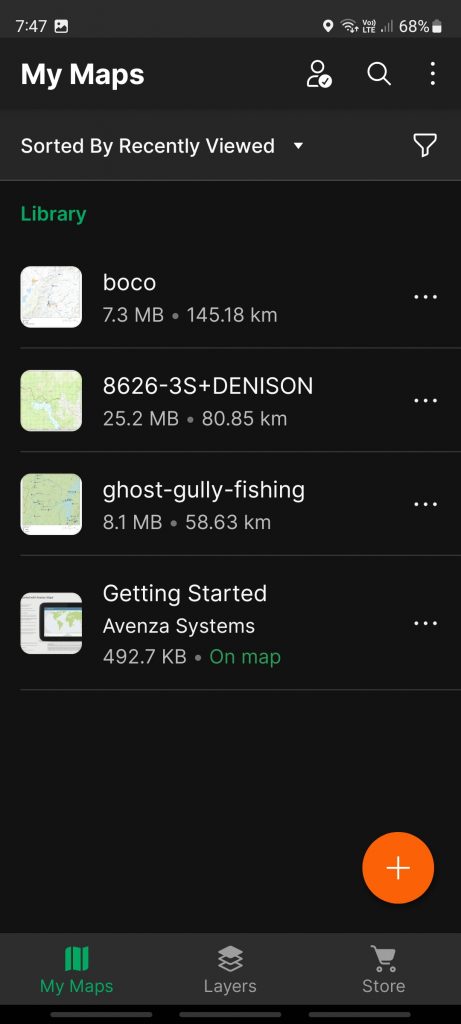
Press the orange + button

Press Download or import a map
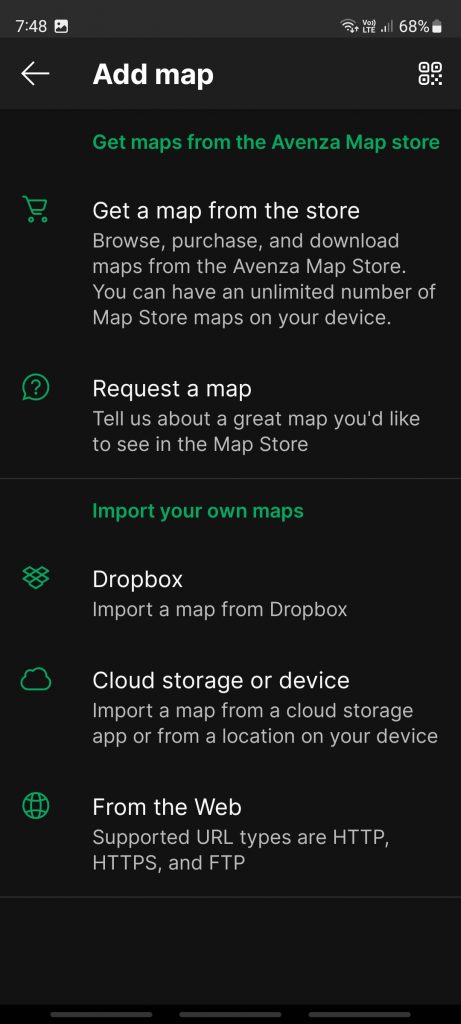
Press Cloud storage or device

Here you can see my map file renamed as Mowamba. If you produced the pdf on your desktop and transferred to phone you may need to navigate to where you stored it. Click on your pdf map name

The message above is because of the 3 map limit, you will not see this when starting to use Avenza. Click on PROCEED ANYWAY

I tapped on the three dots next to an unwanted map and chose to delete it. I suspect the pdf remained on my phone somewhere so I could reload in the future. In due course I could tap on the Mowamba map
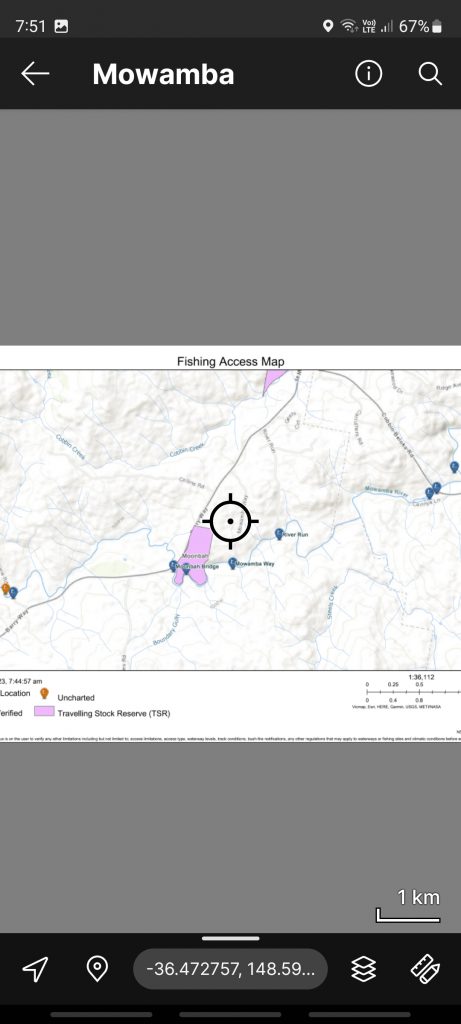
Talk to Bill sometime if the instructions are too confusing and get a live demo.
This free article popped into my inbox today. Provides a very straightforward description of key insects in what looks like a pretty generic way. Even has suggested sizes to match our flies to the natural.
It will likely be North American conditions. We’ll need our resident entomologist, Jaime, to endorse.
https://askaboutflyfishing.fliesforsale.com/match-the-hatch/
As you would expect, offers to sell you appropriate flies at the bottom.
CAA was approached by a local news outlet. They asked a number of questions in preparation for an actual interview. President Claude, with some assistance of others in the club, has assembled the response. It was thought this was worthy of being retained for any future use. Here it is, it will also be included in our ‘Tips’ category.
Carp Fishing Hints:
General. Carp are typically bottom feeders but they can also feed on the surface. Carp are easily tackled from shore, boat, kayak. I wouldn’t recommend using a leader less than 6lb…they don’t have great eye sight and are not leader shy. Use strong hooks – bait or fly…..there are some big suckers out there….below is the result of my last hook-up (and lost) carp!
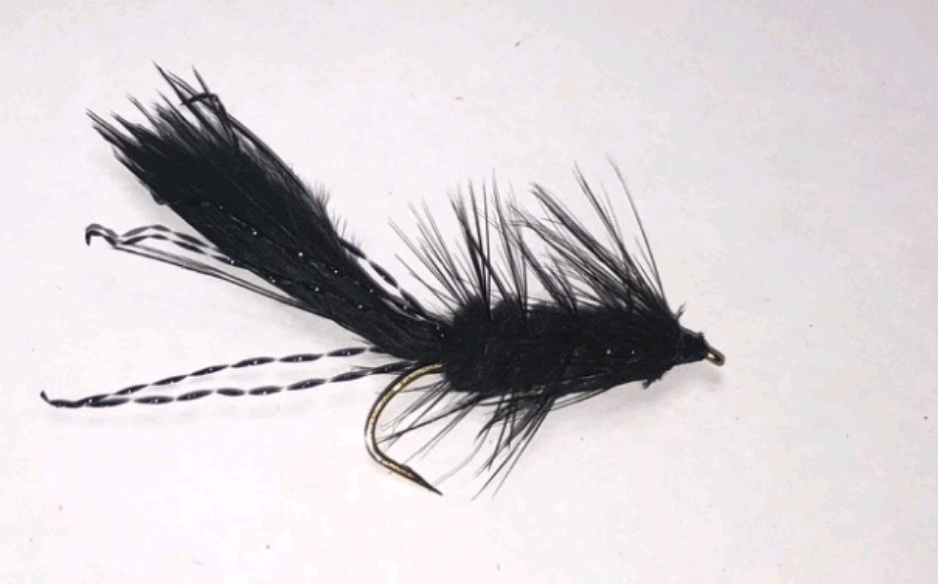
Bait. Corn, bread and/or worms are all great baits. A small circle hook on a 50 cm leader, swivel and the lightest sinker you can cast is my preferred rig. There are plenty of options and suggestions on the web. I have had to chase a couple of rods into the water, so if you leave your rod out of your hand, don’t forget to set a light drag and clip on a bell.
Fly Fishing. You can have a crack at either surface or subsurface tactics. My goal this year is to try to catch a carp on a dry! Nymphs, woolly buggers, bread flies are all options. Drop in and see the guys at the Boss Outdoors for some hints. I also have some fabulous hints from Jason Stratford who has caught over 1000 carp on fly – I’ll provide the hints to those that register for the trip. Another source of information is on his Facebook site ‘Kangaroo Carp’ or YouTube. Leon, one of our club members, has been out successfully practicing (not something that happens to me often). Check out some of the photos at the bottom.
Some detailed hints follow. I’m not sure if these are Claude’s words. #2 rod sounds a bit interesting
Leader set up…
If you keep a basic trout rig in mind when targeting carp, you won’t go wrong. I used to hand tie up tapered leaders but found that debris would get caught on the knots. So now I use factory tapered leaders around 7.5′ – 9′ and just add 2-3′ of tippet. Tippet is entirely dependent on the size of fish and the amount of structure…but for me…I can get away with 8-10lb if I want to muscle fish / using wet flies…6-7lb for dries. You can use tippet rings for wet fly leaders without much issue.
In some places where the fish are highly pressured, very clear water (rare) then I might drop to 5lb for dries but if you hook a 75cm+ carp…you won’t win often as you will have trouble moving the 15 odd pound fish if they belly out on the bottom while you try and reel them in.
Sight fishing vs blind casting…
My style of fishing for carp is ALL sight fishing. By that I mean…I will rarely cast at a tailing fish if I cannot clearly see its head. Roiling fish (fish with head buried in a mud cloud) don’t get much attention from me as I can normally walk a short distance and find a cruising fish or one feeding in the shallows…or on the surface (even better). Note: sometimes you will see plenty of fish together gulping on the surface. This is a spawning aggregation and generally the fish doing that won’t eat. You need to scan the edges of the group and you will see the odd fish feeding / cruising around. Those are the fish to target. Also note that carp generally do not rise to a dry if they are actively feeding on the bottom (unless in very shallow water). They are ‘built’ to be bottom feeders primarily so are also very clumsy surface feeders and can move the fly with their lips (pushing it across the surface) or miss the fly all together. Patience is key…like trout…it’s important to wait until the head drops before setting the hook.
Strip set vs trout strike…
Both work and while I do strip set a lot…the trout strike probably works easier for newcomers as the rod is bent but will still have some shock absorption available when the fish blisters away on its first run…whereas with a strip set…I see a lot of people try and hold the fish (momentarily) which leads to a bust off. Pound for Pound…a carp will pull the head off a trout!!! The easiest way is to just use a steady rod lift as the carp have soft (but very elastic) skin around their mouths so are easy to set the hook on and once set properly, it’s rare for them to spit a hook.
Flies…
Flies are generally unweighted and very slow sinking on size 8-10 wide gape strong hooks. Barbless makes it easier to recover flies from the fish and get the fly back in the water to start fishing quickly. In some places (deeper / current or flow) you do need weighted flies to get the fly down to the fish. Again, my fly selection is different to the ‘norm’. I tie some patterns that work as a dry and can be sunk through the surface file by giving them a twitch / small strip – where they slowly sink. A slow sinking fly that intercepts a mid-water cruising fish at their eye level will very often get a reactive take. There are so many patterns that will work for carp but the woolly worm is a good all round wet fly as are damsel nymphs, plain old woolly buggers, squirmy worm style flies and pretty much anything that looks ‘buggy’. Here is a link to a simple each way bet fly.
https://vimeo.com/194213054
*****************************
On the rod front…use what you are comfortable with.
The rod is merely the delivery method for the size of fly and type of fly line used. I fish a 2wt or 3wt most often as you are limited by the tippet breaking strain and I use fairly small flies compared to a lot of guys and only need to cast short distances (most often 8-10m). Small rods are a lot of fun…I have taken carp around 85cm on the 2wt!
Bigger flies – greater break strain tippet…use the heavier rods. (By that I mean 5 or 6) If you are however in heavy structure…then a beefier rod (7 or above) and heavier tippet may be needed to muscle the fish a bit. If you use carp as ‘training fish’ you will quickly learn how much pressure you can pull through the rod without breaking tippets (which is a lot more than people think if you use good rod angles and ‘roll’ the fish a few times early in the fight).
Most of all…enjoy what you do and how you go about it. Don’t follow what everyone says (use it as a start point and then adjust to suit your local water!)
Beware though…this carp on fly thing can be addictive!!!



Got this important message from Jaime:
Just saw this article about fishing gear that ends up lost and contaminating. The research was done by CSIRO, Australia’s national science agency, and the University of Tasmania. I think it’s good we increase awareness on this issue so we stay motivated to do our part minimising contamination (hope all in the club use any of the different options/tools to dispose tippet material in a more rational way (mono and fluorocarbon, etc).
Try this link below, it’s a nice summary of the original article.
https://www.csiro.au/en/news/News-releases/2022/Fishing-gear-lost-at-sea-globally-revealed
Peter found this hint (including video) – it applies to all big fish it seems to me.
The Lake User Group is examining water safety matters in the context of possible seaplane operations in LBG. CAA will be engaged with the community consultation. Meanwhile the current brochure gives appropriate advice that members may not have seen.